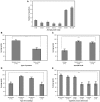Making authentic science accessible-the benefits and challenges of integrating bioinformatics into a high-school science curriculum
- PMID: 26801769
- PMCID: PMC5221422
- DOI: 10.1093/bib/bbv113
Making authentic science accessible-the benefits and challenges of integrating bioinformatics into a high-school science curriculum
Abstract
Despite the central place held by bioinformatics in modern life sciences and related areas, it has only recently been integrated to a limited extent into high-school teaching and learning programs. Here we describe the assessment of a learning environment entitled 'Bioinformatics in the Service of Biotechnology'. Students' learning outcomes and attitudes toward the bioinformatics learning environment were measured by analyzing their answers to questions embedded within the activities, questionnaires, interviews and observations. Students' difficulties and knowledge acquisition were characterized based on four categories: the required domain-specific knowledge (declarative, procedural, strategic or situational), the scientific field that each question stems from (biology, bioinformatics or their combination), the associated cognitive-process dimension (remember, understand, apply, analyze, evaluate, create) and the type of question (open-ended or multiple choice). Analysis of students' cognitive outcomes revealed learning gains in bioinformatics and related scientific fields, as well as appropriation of the bioinformatics approach as part of the students' scientific 'toolbox'. For students, questions stemming from the 'old world' biology field and requiring declarative or strategic knowledge were harder to deal with. This stands in contrast to their teachers' prediction. Analysis of students' affective outcomes revealed positive attitudes toward bioinformatics and the learning environment, as well as their perception of the teacher's role. Insights from this analysis yielded implications and recommendations for curriculum design, classroom enactment, teacher education and research. For example, we recommend teaching bioinformatics in an integrative and comprehensive manner, through an inquiry process, and linking it to the wider science curriculum.
Keywords: Bloom’s taxonomy; assessment; bioinformatics education; domain-specific knowledge; secondary school.
© The Author 2016. Published by Oxford University Press.
Figures




Similar articles
-
Integrating bioinformatics into senior high school: design principles and implications.Brief Bioinform. 2013 Sep;14(5):648-60. doi: 10.1093/bib/bbt030. Epub 2013 May 10. Brief Bioinform. 2013. PMID: 23665511 Review.
-
Evaluating the effectiveness of a practical inquiry-based learning bioinformatics module on undergraduate student engagement and applied skills.Biochem Mol Biol Educ. 2016 May 6;44(3):304-13. doi: 10.1002/bmb.20954. Biochem Mol Biol Educ. 2016. PMID: 27161812 Clinical Trial.
-
From Inquiry to Insight: Unlocking the Potential of Students' Questions in Medical Education in Singapore.Teach Learn Med. 2025 Apr 1:1-10. doi: 10.1080/10401334.2025.2481400. Online ahead of print. Teach Learn Med. 2025. PMID: 40165612
-
Students' Experiences of Working With a Socio-Scientific Issues-Based Curriculum Unit Using Role-Playing to Negotiate Antibiotic Resistance.Front Microbiol. 2021 Jan 20;11:577501. doi: 10.3389/fmicb.2020.577501. eCollection 2020. Front Microbiol. 2021. PMID: 33552005 Free PMC article.
-
A survey of scholarly literature describing the field of bioinformatics education and bioinformatics educational research.CBE Life Sci Educ. 2014 Winter;13(4):607-23. doi: 10.1187/cbe.13-10-0193. CBE Life Sci Educ. 2014. PMID: 25452484 Free PMC article. Review.
Cited by
-
Teaching a difficult topic using a problem-based concept resembling a computer game: development and evaluation of an e-learning application for medical molecular genetics.BMC Med Educ. 2019 Oct 24;19(1):390. doi: 10.1186/s12909-019-1817-2. BMC Med Educ. 2019. PMID: 31651301 Free PMC article.
-
Integrating Biomedical Informatics Training into Existing High School Curricula.AMIA Jt Summits Transl Sci Proc. 2021 May 17;2021:190-199. eCollection 2021. AMIA Jt Summits Transl Sci Proc. 2021. PMID: 34457133 Free PMC article.
-
MySeq: privacy-protecting browser-based personal Genome analysis for genomics education and exploration.BMC Med Genomics. 2019 Nov 27;12(1):172. doi: 10.1186/s12920-019-0615-3. BMC Med Genomics. 2019. PMID: 31775760 Free PMC article.
-
Molecular modelling as the spark for active learning approaches for interdisciplinary biology teaching.Interface Focus. 2019 Jun 6;9(3):20180065. doi: 10.1098/rsfs.2018.0065. Epub 2019 Apr 19. Interface Focus. 2019. PMID: 31065338 Free PMC article.
-
Bioinformatics-Based Activities in High School: Fostering Students' Literacy, Interest, and Attitudes on Gene Regulation, Genomics, and Evolution.Front Microbiol. 2020 Oct 14;11:578099. doi: 10.3389/fmicb.2020.578099. eCollection 2020. Front Microbiol. 2020. PMID: 33162959 Free PMC article.
References
-
- National Institutes of Health [NIH]. NIH working definition of bioinformatics and computational biology. http://www.bisti.nih.gov (17 July 2000 date last accessed).
-
- National Center for Biotechnology Information [NCBI]. A science primer: bioinformatics. http://www.ncbi.nlm.nih.gov/About/primer/bioinformatics.html (15 June 2011 date last accessed).
-
- Counsell D. A review of bioinformatics education in the UK. Brief Bioinform 2003;4:7–21. - PubMed
-
- Koch I, Fuellen G. A review of bioinformatics education in Germany. Brief Bioinform 2008;9:232–42. - PubMed
-
- National Research Council [NRC].BIO2010: Transforming Undergraduate Education for Future Research Biologists. Washington, DC: The National Academies Press, 2003. - PubMed
MeSH terms
LinkOut - more resources
Full Text Sources
Other Literature Sources

